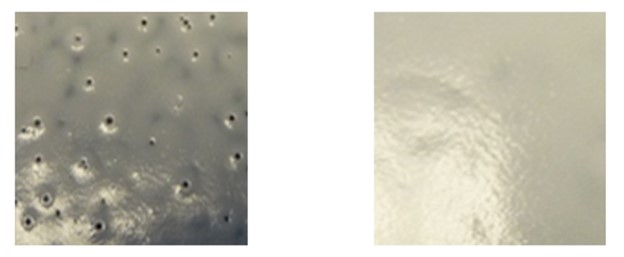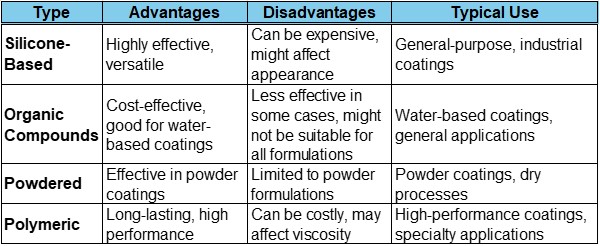Guest post by Jeremy Pasatta, Advanced Polymer Coatings
When it comes to high-quality coatings, whether they’re for industrial applications, consumer products, or architectural finishes, one issue that can significantly impact performance and appearance is foam. Foaming in coatings can lead to defects like poor surface finish, inconsistent application, and compromised durability. The foam can be formed at several points in the process, including during the grinding and milling of pigments, during filling of the coating into packaging, during application, especially brushing and rolling and in thick films and on textured or porous substrates. To address this, anti-foam agents—also known as defoamers—play a crucial role. In this blog post, we’ll explore what anti-foam agents are, how they work, and their importance in coating formulations.
Anti-foam agents are substances added to coatings to prevent or reduce the formation of foam. Foaming can occur during the manufacturing process, application, or even while the coating is drying or curing. These agents work by destabilizing foam, allowing bubbles to break and preventing them from forming in the first place by interacting with the foam structure at a molecular level. They typically consist of hydrophobic compounds that disrupt the film that stabilizes bubbles. By breaking down the foam structure, these agents help to maintain the integrity of the coating and ensure a smooth, uniform finish.
The three primary mechanisms for breaking up foam and bubbles are listed below:
- Defoaming Action: The anti-foam agent rapidly disrupts the foam structure, causing bubbles to coalesce and burst.
- Hydrophobic Interaction: Many defoamers are hydrophobic, and therefore repel water and prevent the stabilization of foam.
- Film Breakdown: The anti-foam agent weakens the surface tension of the bubbles, causing them to collapse.
The mechanism of film breakdown, or weakening of the surface tension, is shown in Figure 1. In this mechanism, the insoluble anti-foam agent enters the bubble wall (as shown by the yellow spheres in Figure 1), coalesces and eventually weakens the bubble wall, allowing the air to escape and resulting in the breakdown of the bubble wall.
Figure 1. Film Breakdown Through Anti-Foam Agents [1].
The effect of these anti-foam agents in coatings is shown visually in Figure 2, with the image on the left containing no defoamer and the image on the right containing only 0.25% by weight of a defoamer.
Figure 2. Visual Effect of Anti-Foam Agent at 0.25% in Coatings [1].
There are several types of anti-foam agents used in coatings, each with specific properties and applications.
- Silicone-Based Anti-Foam Agents: Highly effective and versatile, these agents are used in a variety of coatings. They work by forming a silicone layer that prevents foam formation from occurring.
- Organic Compounds: These include fatty acids, alcohols, and esters. They work by disrupting the foam structure and are often used in water-based coatings.
- Powdered Anti-Foam Agents: Used primarily in powder coatings, these agents dissolve during the coating application process to prevent foam.
- Polymeric Agents: These are often used in high-performance coatings and provide long-lasting foam control by creating a stable anti-foam network.
The main advantages, disadvantages and end uses of each of these types of anti-foam agents in summarized in Table 1.
Table 1
Effective bubble management is crucial for several reasons:
- Surface Quality: Bubbles can lead to surface imperfections such as pinholes or craters. Anti-foam agents help ensure a smooth, defect-free surface ensuring maximum gloss and corrosion protection.
- Application Consistency: Foam can affect the uniformity of application, leading to inconsistent and potentially low coverage which can affect overall corrosion and chemical resistance. Anti-foam agents promote an even application.
- Durability: Persistent foaming can weaken the coating film, affecting its longevity and protective properties. Bubbles within the coating, especially when at the coating/substrate interface, can affect the adhesion of the coating.
- Aesthetic Appeal: Foaming can impact the final appearance of the coating, making anti-foam agents essential for achieving the desired finish.
When selecting an anti-foam agent, it’s important to consider compatibility. If an insoluble defoamer is chosen, it must remain evenly dispersed within the coating to effectively disrupt bubble formation. The level of defoamer is also critical. Most defoamers are only used at percentages less than 1%. When the concentration of defoamers is too high, especially with silicone based anti-foam agents, they can often cause adhesion issues by disrupting the bonding of the matrix resin to the substrate.
In this blog post, we have seen that anti-foam agents are essential components in the formulation of high-quality coatings, ensuring that foam is managed effectively to maintain the coating’s appearance, performance, and durability. By understanding the types of anti-foam agents available and their specific applications, you can make informed choices that enhance the overall quality of your coatings. Whether you’re dealing with industrial applications or consumer products, proper bubble management is key to achieving a flawless finish and reliable performance.
References:
- https://exovio.de/about/




Consider if you will certain decoupage coatings and castings. It’s our experience that some of these small micro bubbles actually form within the mixed material can’t be detected by eye and only become visible when the material is fully crosslinked. We are led to believe they are an off gassing from the polyetheramine nonylphenol reaction. Do you have any insight to share on that? Ronnie Dubs
Microbubbles can form as an off gassing for may different types of curing reactions. You are correct that often these types of microbubbles are not visible to the naked eye and often show up in the final cured part as a haze or what appears to be microvoids. The same principles of defoamers can be used to eliminate these microbubbles, and with a proper defoamer can allow these small bubbles to coalesce and quickly reach the surface and break. Viscosity, gel time and coating thickness of the formulation must also be considered. For highly viscous formulations, these microbubbles that are formed during curing will have a harder time reaching the coating surface, and if the coating gels or cures quickly the microbubbles can be trapped in the coating before they have a chance to escape. For thicker coatings, the same will be true where it will be harder for the bubbles to reach the surface before curing. With the right choice of defoamer and coating formulation, these bubbles that form as a result of the curing process can be minimized or eliminated.